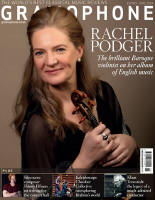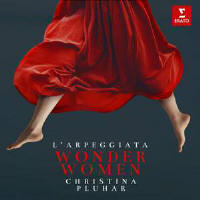Texte paru dans: / Appeared in:
|
|
|
|
|
|
The booklet notes open with declamatory words by Maddalena Casulana, the 16th-century composer, lutenist and singer: ‘I wish … to also show the world (to the degree that it is granted to me in my profession as a musician) the foolish error of men who so believe themselves to be the masters of high intellectual gifts that it seems to them these cannot be equally common among women.’ A Renaissance wonderwoman indeed; but instead of wearing a cape, she plays a lute.
L’Arpeggiata director Christina Pluhar is cut from the same cloth. We’re told that the album is a tribute to female composers of the 17th century as well as a celebration of ‘all aspects of womanhood, and women with all their talents’. There’s music, as you might expect, from nowhousehold names Francesca Caccini, Barbara Strozzi and Isabella Leonarda. But there are also wonderful surprises in the mix, including traditional songs from Mexico and Italy – and seven arrangements by Pluhar. Much narrative ground is covered, too, with everything from heroines to sorceresses.
All four vocal soloists are exceptional. Soprano Céline Scheen in Strozzi’s Che si può fare? is an obvious highlight. This lovelorn lament is actually sung from a male perspective; Scheen’s excellent controlled vibrato brings a tenderness to the character’s distress. Mezzo-soprano Benedetta Mazzucato is equally stunning in Leonarda’s Nive puer. Her effortless melisma brings to life the exquisite wordpainting on ‘cantans’, and if you could bottle the sound of her humming, the cupboards of parents dealing with newborns would be full. Mazzucato’s clarity is perfect in conjuring the frost-
sparkled scene (the text of the recitative is especially delightful, describing how Mary ‘sprinkled melodies among her sighs’ as she rocked the baby Jesus to sleep). The performances by male alto Vincenzo Capezzuto are remarkable. Capezzuto’s personal website claims that his voice ‘escapes any kind of classification’, and indeed, timbre and tessitura are excellently explored here to conjure what the author of the booklet notes calls ‘gender porosity’.
There are ridiculous musical moments – from Manuel Barreto’s fabulously ostentatious harp-playing that spills into camp celebration in the album’s opening track, to the sensual double-bass pizzicato in the traditional Mexican song ‘La Llorona’. But if you know the largerthan-life Pluhar, this all makes utter sense. Such timbral and textural detail is always a strength of L’Arpeggiata; Pluhar’s attention to plucked and percussive resonance is so strong in evocation (although I don’t know if I love or hate the percussion in Nive puer). There are the usual swirling chaconne bass lines that we’ve come to expect and love from L’Arpeggiata, and the quiet rhythmic funk of ‘La Lloroncita’ is exactly what is needed to break the spell. |
|




